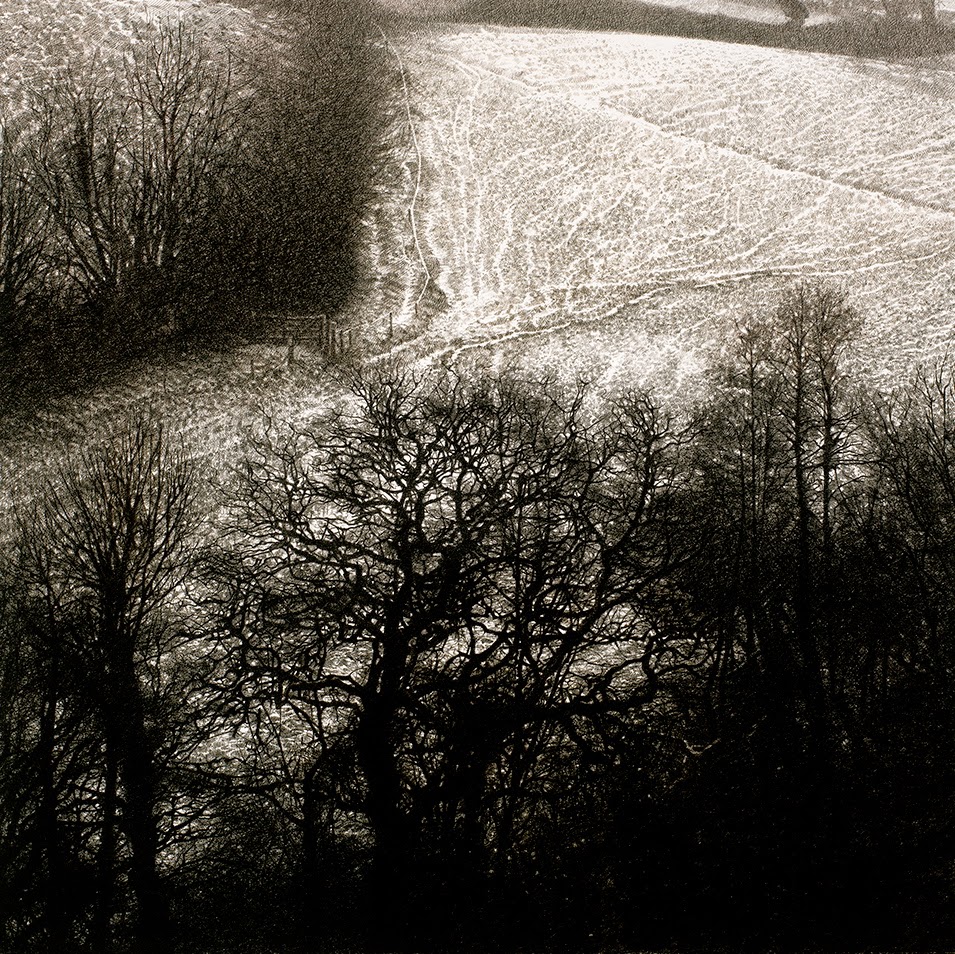I have walked three fields before I notice that I’ve noticed nothing. Well, perhaps not quite nothing. I had, with some glee, registered the frost on first stepping out and I’d enjoyed breaking the ice in a puddled tractor rut near the barn in the second field. Other than that, by the time I get to the top of Gutteridge hill, I haven’t seen a thing. I am, again, entirely occupied by my own thoughts – engaged only with my own affairs, making lists, talking to myself, rehearsing conversations, imagining….
A style of five stone steps leads down into the fourth field. Gutteridge. A minor miracle of a field; west-facing, steeply ridged pasture, I don’t imagine it’s ever felt a plough. In spring and summer, watercress grows in it’s streams and orchids, louse-wort and tiny, red oak seedlings proliferate in the tight grass. This morning it is empty and pale, its ridges starred with frost and the palest yellow of a very few primroses. But I see nothing. Squeezing through the tight gap in a dense patch of gorse below the style, mind yabbering inwardly on, (filling in an application form, remembering to ring the bank, ring the gallery, order more pencils, worrying about one of the children.) Nothing at all.
Once in the open, body – on autopilot – has turned left to skirt the top edge of the field, when something – a sound – finally penetrates. Body stops. Even mind stops, (mid e-mail,) registers thin sun through eyelashes and wonders, ‘what is that?’
Birdsong.
A birdsong. One bird. Exquisite random noise – ringing out. Turning now, each burst seems to be unique, different from the last, the variety and clarity of the short sequences, rising above the more general music of the valley, (many birds, the stream at the bottom of the hill, sheep, a pair of canada geese above the far woods – did I hear their wingbeats too?) As the valley comes into focus, it takes a few more seconds before my over-crowded brain comes up with – ‘thrush!’
Staring hard at the high hedge of hawthorn, hazel and ash that borders the descending northern edge of the field, I can’t make her out. This is Devon so, as so often, the trees are not against the sky but against the steeply rising flank of another, farther field. The field-hedge is an essay in greys: mouse, moss and steel in the early February light. Catkins provide a few fine brush-marks of cinnabar green. The field behind, (a ridged permanent pasture, clipped short by my neighbour’s sheep,) is winter green, silvered by the frost.
Where is she?
Moving down the hill, putting my boots sideways in the ridges, I scan the hedge until my eyes find her, a Mistle Thrush, high in the branches of a hawthorn. She could be part of the tree – is a part of the tree. WB Yeats wrote of swans that their ‘storm of white’ seems ‘but a concentration of the sky’ *- Now, suddenly, this handful of speckled feathers, a heart and some bones, strikes me as a concentration of the hawthorn. The old tree’s lacework of branches, lichen and few remaining frozen berries gathered into a ‘generated soul’. Given breath, she flings her song out into the valley. Over and over. Sings the stream, sings the red tips of the oak trees, sings – commands – the sun to come over the hill and push the soft frost down into the bottom of the folds. Sings, (in that moment I am sure,) even the space – the frosted air – between things. Do I imagine the urgency? Can she really be singing the valley into existence?
Edging closer, greedy for detail, I can see beak opening and closing, even tender flashes of pink inside mouth, when the head turns to ensure the existence of things in my direction. Now when she turns thus, I can see the patterning on throat and breast. The speckling, the makers marks, hawthorn-grey on cream, rising and expanding with each new intake of breath. Minutes pass. On and on the thrush casts her mad, indescribable song into the morning. The stream chatters back and the frost-shadow inches its way down the far side of the hill.
There is time too to notice this: I am not the centre of my own universe. Four ounces of thrush, singing from the tip of her hawthorn, instructs the ten thousand things – and I am just one of them. The relief makes me laugh out loud.
From behind me, in the bleached ‘stag head’ branches of an oak tree, a crow utters two low ‘caws’ and lifts himself into the air.
“…if we do not hear the voices of the trees, the birds, the animals, the fish, the mountains and the rivers then we are in trouble…that, I think, is what has happened to the human community in our times. We are talking to ourselves. We are not talking to the river, we are not listening to the river. We have broken the great conversation. By breaking the conversation we have shattered the universe. All these things that are happening now are the consequences of this ‘autism’.”
Thomas Berry. Befriending the Earth: A Theology of Reconciliation between Humans and the Earth.
* WB Yeats Coole Park and Ballylee 1931
“Oaks and Light Snow” Charcoal on Paper 27″ X 27″ © Sarah Gillespie 2012
“Nest” Watercolour and Charcoal on Paper 18″ X 12″ © Sarah Gillespie 2013

